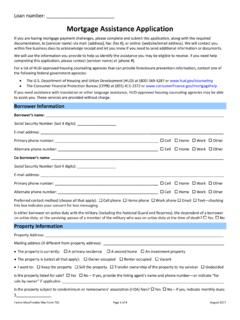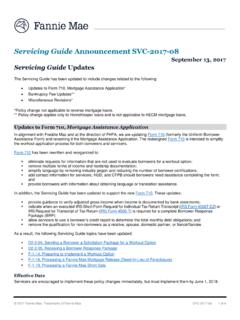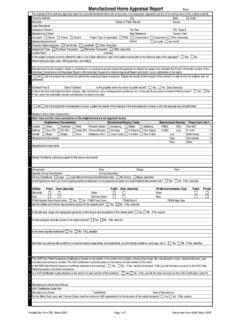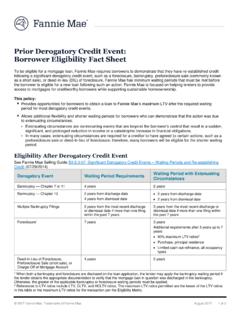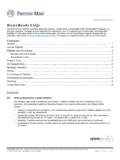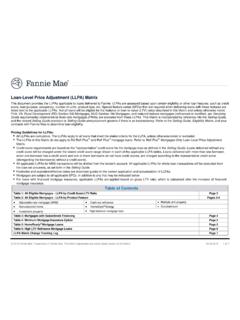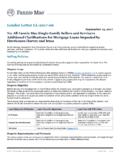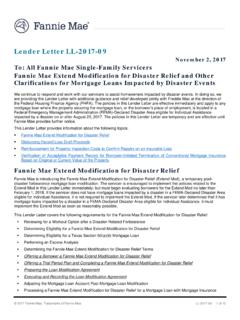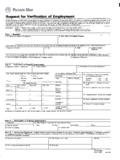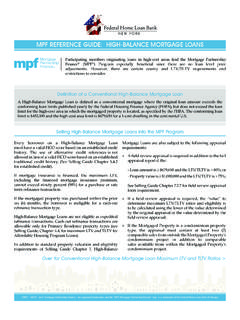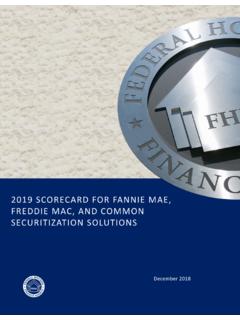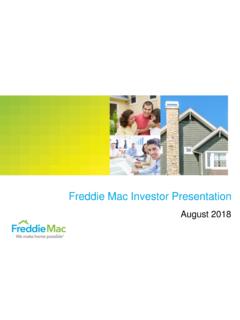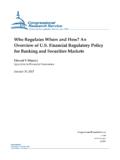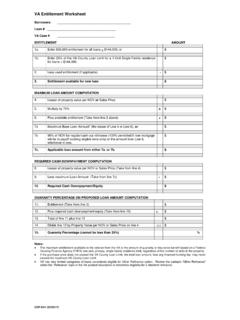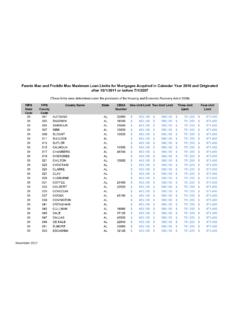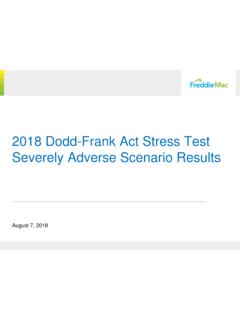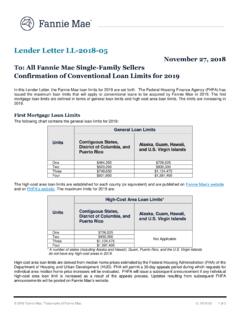Transcription of The Single Security Initiative - Fannie Mae
1 The Single Security Initiative 1. What is the Single Security Initiative ? The Single Security Initiative is a joint Initiative of Fannie Mae and Freddie Mac (the Enterprises), under the direction of the Federal Housing Finance Agency (FHFA), the Enterprises' regulator and conservator, to develop a common mortgage-backed Security (MBS) that will be issued by the Enterprises to finance fixed-rate mortgage loans backed by one- to four-unit Single -family properties. The 2014 Strategic Plan for the Conservatorships of Fannie Mae and Freddie Mac [PDF] (2014 Conservatorship Strategic Plan) includes the goal of developing a common MBS. This goal is part of broader efforts to build a Common Securitization Platform (CSP), and it supports FHFA's statutory obligation to ensure that the Enterprises' operations and activities foster liquidity in the nation's housing finance markets.
2 Achievement of the goal will also reduce or eliminate Freddie Mac's current program of subsidizing the cost of securitizing Single -family mortgage loans to make up for the trading disparity with Fannie Mae's securities, the cost of which is being borne by taxpayers. 2. What are first-level and second-level securities? First-level securities (Uniform Mortgage-Backed Securities, or UMBSTM) are Single -class securities backed by mortgage loans purchased by either Freddie Mac or Fannie Mae. There is no commingling of collateral in UMBS. Similar to today's Fannie Mae Megas and Freddie Mac Giants, second-level securities (Supers) are Single -class securities collateralized by other Single -class securities.
3 Supers securities will allow for the commingling of Freddie Mac and Fannie Mae UMBS as well as other Supers. 3. Is it expected that legacy Fannie Mae MBS and legacy Freddie Mac participation certificates (PCs) will be fungible with the UMBS? The features and characteristics of the UMBS will be based generally on Fannie Mae MBS characteristics and, as such, Fannie Mae MBS will be fungible with the new Security . In essence, Fannie Mae MBS will become the new Security and Freddie Mac will make changes to its Security structure to more closely match Fannie Mae's Security , resulting in a common UMBS. Freddie Mac will offer investors the option to exchange legacy Freddie Mac PCs for comparable UMBS backed by the same mortgage loans.
4 4. Who would be the guarantor of the new securities? As with current Enterprise securities, for the new securities issued after the implementation of the Single Security Initiative , the guarantor will be the issuing Enterprise. 5. Could the guarantor be different between a first-level UMBS and a second-level Supers? The guarantor could be the same, or it could be different. For each, the guarantor is always the issuing Enterprise. Fannie Mae and Freddie Mac will each issue their own UMBS. At the second level Supers collateral may be mixed Fannie Mae and Freddie Mac UMBS and/or Supers, or a Single issuer's securities. In either case, the Supers Security could be issued by either Fannie Mae or Freddie Mac, regardless of whether their own collateral is contained in the Security .
5 See the example on page 1 of Appendix B of the Update on the Structure of the Single Security for information related to counterparty risk. 6. Can a Fannie Mae first-level Security and a Freddie Mac first-level UMBS be commingled into the same Fannie Mae or Freddie Mac second-level Security ? Yes. 7. When is commingling allowed? Does it affect the status of the guarantor? Single Security Initiative FAQ May 2018 Final Ver 1. Commingling is allowed in second-level but not in first-level securities. In either context, the guarantor is the issuing Enterprise. For example, an investor who owns a first-level Security issued by one Enterprise will be able to re-securitize it through the second Enterprise by paying any applicable fee.
6 The timely payment of principal and interest on the resulting second-level Security will be guaranteed by the second Enterprise, and that guarantee will be supported by the first Enterprise's guarantee to the trust of the second-level Security of timely payment of principal and interest on the first-level Security . 8. Will market participants need to update their documents and websites to reflect the new Security names (UMBS and Supers)? Yes, the Enterprises expect that investors, dealers, vendors, and others will need to update contracts, marketing materials, investment documents, systems, and procedures to reflect the new names of TBA-eligible mortgage- backed securities. The Enterprises are already using the names UMBS and Supers in their outreach to raise awareness of needed name changes.
7 The goal is to provide the market as much preparation time as possible in advance of the Single Security Initiative implementation date of June 3, 2019. 9. What will FHFA and the Enterprises do to ensure their securities stay aligned in performance once the Single Security Initiative is implemented? UPDATED. FHFA has established the Single Security Governance Committee (SSGC) composed of senior FHFA executives to assess new or revised Enterprise programs, policies, and practices for their effect on the cash flows of MBS eligible for financing through the TBA market. FHFA will also perform ongoing monitoring of loan acquisitions, Security issuances, and prepayments and ensure that the Enterprises continue to provide information on a timely basis to facilitate these ongoing assessments.
8 FHFA is seeking general alignment on the observed prepayments associated with Enterprise UMBS at the cohort level. FHFA will monitor the respective prepayment rates of both Enterprises and has established tolerance thresholds for prepayment divergence between the Enterprises. Generally, FHFA will investigate differences between Fannie Mae and Freddie Mac prepayment speeds when cohort speeds diverge by more than 2 CPR. When differences exceed 3 CPR, FHFA will require that the cause of the divergence be reported to the SSGC. The Enterprises remain separate entities with separately issued and guaranteed securities. Each Enterprise will continue to create its own trust agreements and disclosure documents, and must perform its own functions as issuer, master servicer, guarantor, and trustee in an independent manner.
9 FHFA does not believe that complete alignment of the Enterprises, programs, policies or practices is necessary or appropriate. The Common Securitization Platform (CSP). Overview 1. What is the CSP and how does it relate to the Single Security Initiative ? CSP is a technology and operational platform that will perform many of the core back office functions for the UMBS and Supers, as well as most of the Enterprises' current securitization functions (bond issuance, settlement, disclosure, bond administration and tax reporting) for Single -family mortgages, on behalf of both Enterprises. The CSP is necessary for the implementation of the Single Security Initiative . It enables the Enterprises to implement one aligned new standard Security in one common system rather than each Enterprise building to that standard in its own legacy systems.
10 The CSP also makes administering commingled securities much more efficient because all the data from both Enterprises is on one platform. 2. Why have a CSP? Neither Enterprise's current systems can execute commingled re-securitizations, which are critical to the success of the Single Security Initiative . Under FHFA's direction, the CSP was undertaken as a joint Initiative by the Single Security Initiative FAQ May 2018 Final Ver 2. Enterprises to develop one common, flexible technological and operational platform to support the back office activities related to Single -family securitization. These activities involve storing, processing, and transmitting large volumes of data, so that investing in a Single platform and carrying out the accompanying operational capabilities to support these functions will benefit both companies, and ultimately, taxpayers.
